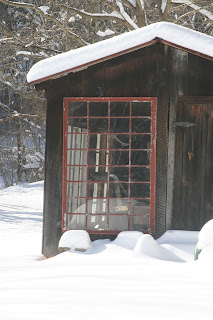It just wouldn't be New Years Day without black eyed peas and collards. Plus, you will need some pork to cook the greens and collards. And you need some cornbread and a bit of potato salad. So now I will be rich in 2016.
A few words about dinner.
Not to bitch and moan in the new year, but it is really important that we begin to expand the food on our tables. If that means spending a bit more to shop with local farmers, then so be it. In an attempt to streamline our food consumption, we have let corporations take over. Instead of producing more food, they have severely limited the food we see in the grocery store. Yet all around the country, in back yard plots and small farms, people are planting seeds they have saved for generations. Take a look at today's cornbread.

In a grocery store, one can fine dozens of different "brands" of cornmeal, but the corn is either yellow or white. In the most gourmet of establishments, one might run across an occasional bag of blue cornmeal. But what about cornmeal from the 1800's? Our cornbread was made with an old dent corn produced in when Native American corn cross pollinated with white settler's corn. The result is Bloody Butcher Corn, a bright red, amazingly moist, with a truly beautiful texture unheard of with store bought meal.
In the hills of West Virginia, the corn was a staple and on many farms it still is.This corn was grown and ground at Hawthorne Valley Farms, just up the road from here. Like most families who grow the corn, the seeds originally came from ancestors who passed them down from generation to generation. These farmers are seed savers and for the rest of the country, they often make the excess seeds available to others.
Our pork came from just down the road.
The Jennings Brae Bank Farm is run by young farmers who will quite literally put the food on our tables in the future...and now. They put a lot of the meat we eat on our table already! Once again, the meat we get from the farm bears little resemblance to the meat you find in a grocery store. Truth be told, you will find the prices of meat from a local farmer to be quite close to what you might pay in the grocery and the quality will be remarkable.
And now a personal plug. In late October as the weather looked like it would be getting colder (who knew it would be 72 on Christmas Eve) we set out make up a batch of Fire Cider, an old remedy for snifflily ailments. Everyone has a different recipe, but mine went something like this.
Fire Cider
In a sterilized quart jar add...
1 sliced orange (or lemon, lime or whatever citrus one might have)
1 thumb sized piece of turmeric, sliced
1 thumb sized piece of ginger, sliced
4 cloves of garlic, smashed
4 habanero peppers, pricked with a knife
6 whole black peppercorns
1 tablespoon of honey
Bragg Organic Cider Vinegar to fill the jar.
Put a plastic lid on the jar and shake. Let sit on the window sill for 3 to 4 weeks. Strain out solids and store in a glass jar.
The few times we have found that little scratch in the back of the throat, we have taken a spoon or two of Fire Cider and felt much better.
Today when we were looking at dinner, we though about vinegar for the greens and remembered the Fire Cider. While we have used it for medicinal purposes, we found it was a perfect accompaniment for greens. The spice was great, the floral citrus undertones offered a complex contrast to the greens.
We do love to make things with multiple uses. Fire Cider, healthy and tasty!
So, once again, Happy New Year. Thank you, thank you, thank you for reading our blog and checking in on our rambling life here in the hollers of West Virginia! We don't tell you nearly enough how much we cherish your support and friendship.
Finally, if you are looking for a few easy to keep and thoughtful resolutions may we suggest...
Find and befriend a farmer.
Try new food.
Put something up, like Fire Cider or jam.
Read more books.
Enjoy life!
Again, thanks to all of you!




























